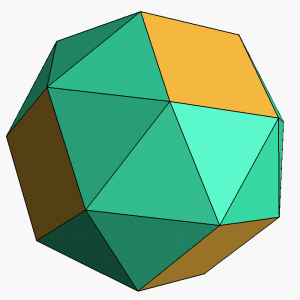Peculiar Cube

A convex, vertex-transitive polyhedron is composed of squares and equilateral triangles with 5 faces joining at each vertex.
If is the number of square faces and is the number of triangle faces, compute
The answer is 192.
This section requires Javascript.
You are seeing this because something didn't load right. We suggest you, (a) try
refreshing the page, (b) enabling javascript if it is disabled on your browser and,
finally, (c)
loading the
non-javascript version of this page
. We're sorry about the hassle.
If the solid is convex and regular, then we can apply Euler's characteristics for number of vertices V , edges E , & faces F :
V − E + F = 2
Let x = number of squares and y = number of triangles.
Now when constructing this solid, each edge is adhesion between two faces, so E = 2 4 x + 3 y .
Similarly, when constructing this solid, each vertex is joining of 5 faces, so V = 5 4 x + 3 y .
Finally, F = x + y .
Therefore, 5 4 x + 3 y − 2 4 x + 3 y + ( x + y ) = 2 .
( 1 0 − 3 ) ( 4 x + 3 y ) + x + y = 2
5 − 6 x − 1 0 9 y + x + y = 2
1 0 y − 5 x = 2
y − 2 x = 2 0
Now if we disregard the triangular faces, we can see that the square faces occupy the whole vertices of the solid themselves. That is, V = 4 x .
Hence, 4 x = 5 4 x + 3 y .
2 0 x = 4 x + 3 y
1 6 x = 3 y
Plugging in y = 2 0 + 2 x from the first equation:
1 6 x = 6 0 + 6 x
Therefore, x = 6 , and y = 3 2 .
As a result, x y = 1 9 2 .